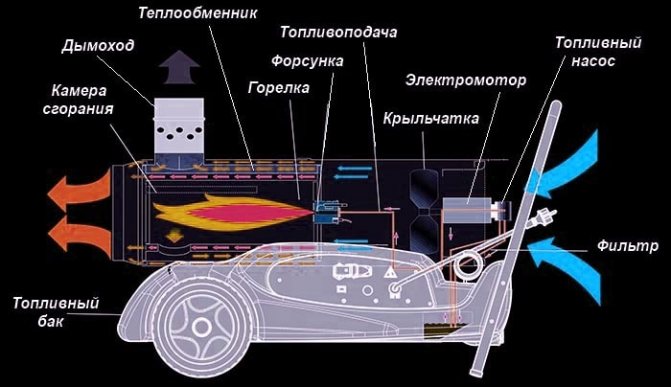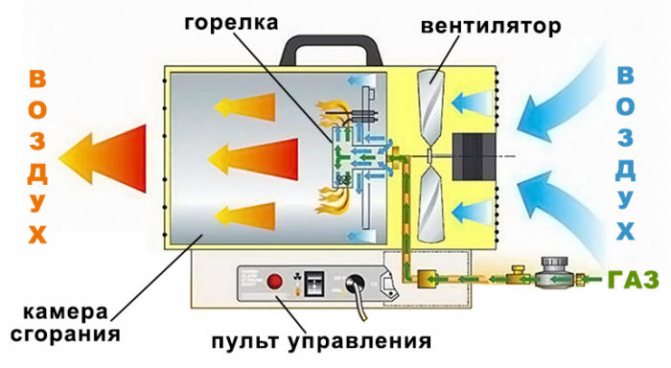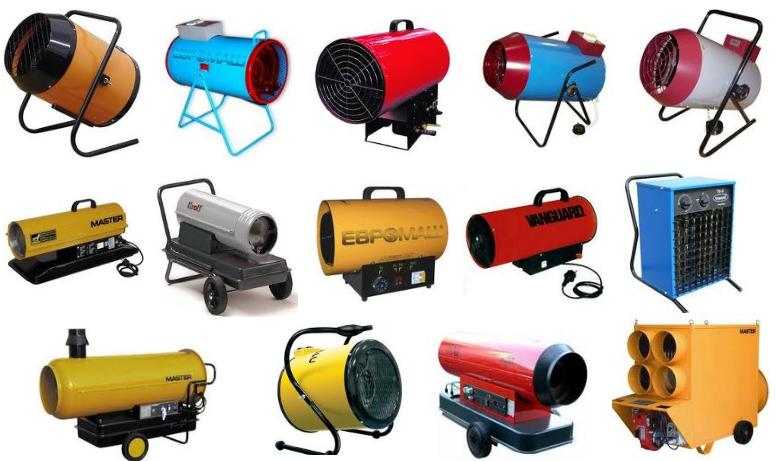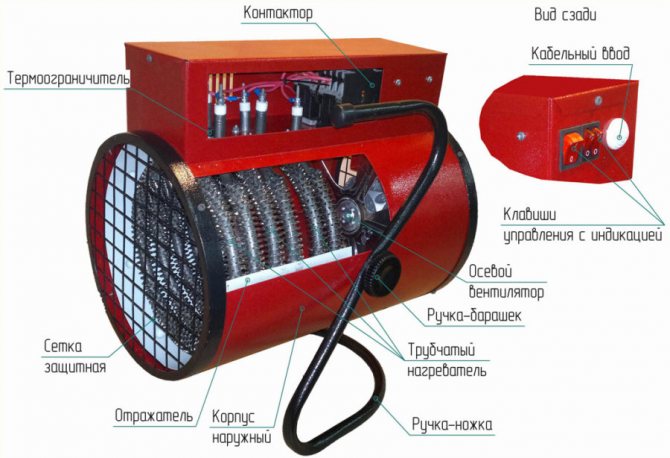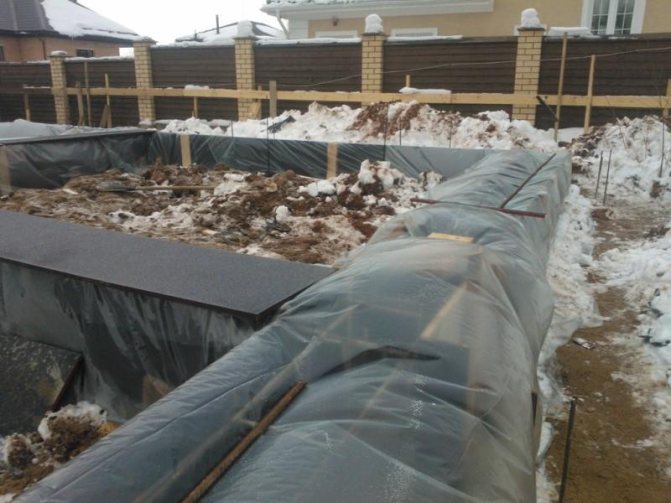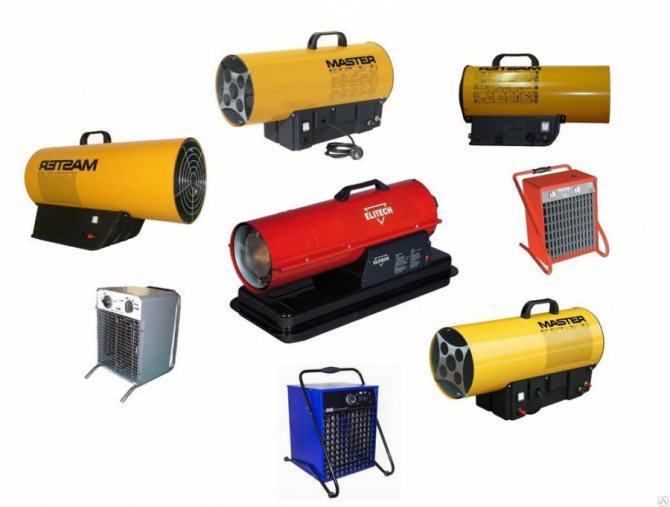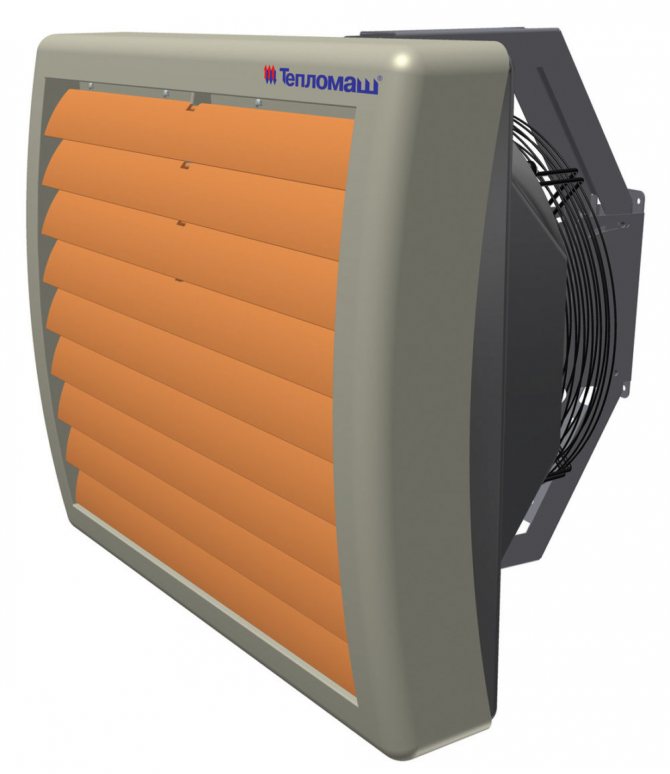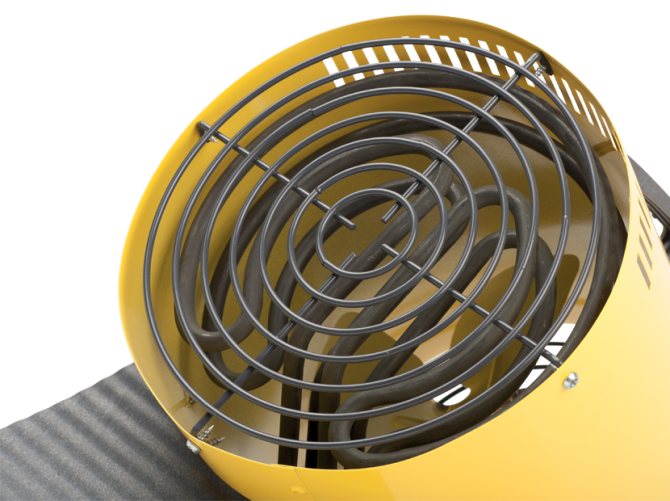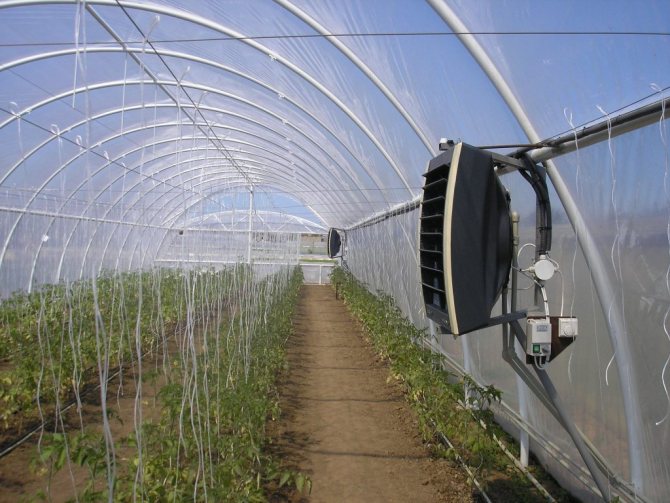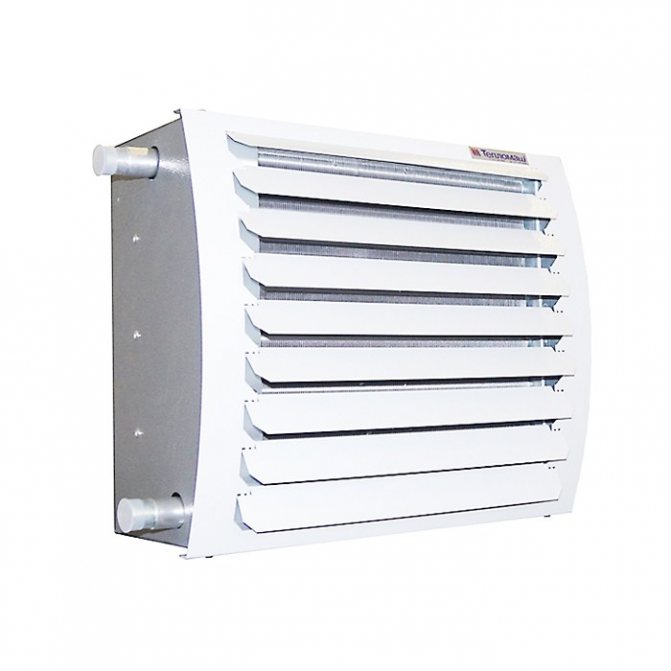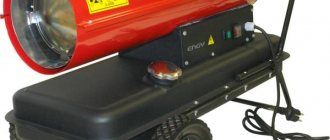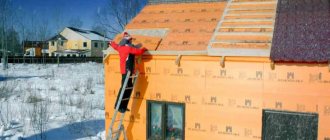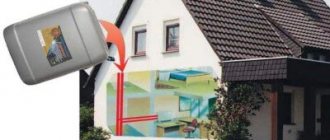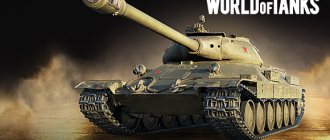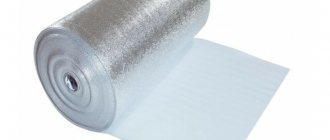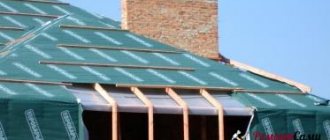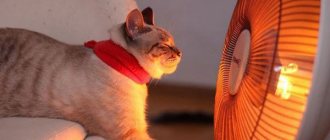Here you will find out:
- Heat gun design
- Types of heat guns and their differences
- Comparison of types of guns
- How to choose an electric heater gun
- Cannon selection criteria
- Which manufacturer to prefer
Heating units are widely used for heating buildings for various purposes:
- living quarters;
- utility room;
- basements;
- garages;
- trade pavilions and sites;
- warehouses;
Heat gun design
The unit is a cylindrical base that is fixed on an axle with wheels and a stand... The angle of inclination of the pipe is set using a regulator, which makes it possible to direct the warm flow to the desired zone.
The high-quality metal body is equipped with grilles through which the air is drawn from the room. An internal heating element brings the air masses to the set temperature, and the fan system pushes them out. Thus, air is circulated with its transformation through the cylindrical part of the heat gun.
The principle of operation of the mechanism resembles that of a fan, with the only difference that heating elements are connected in parallel, giving out a heated stream.
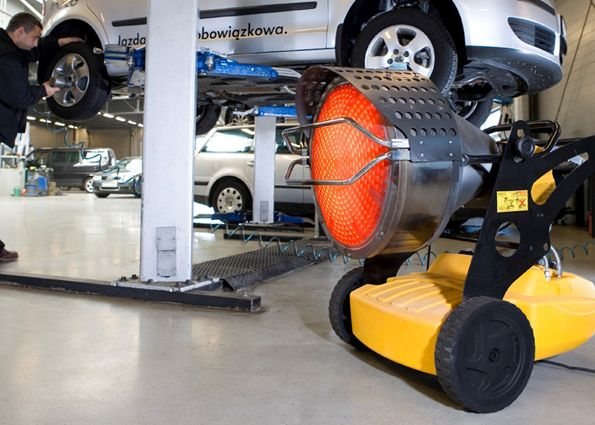
Infrared models
If you are still wondering how to choose a heat gun for space heating, look at the infrared models. They also use powerful fans to help pump the heat that comes from the heated element.
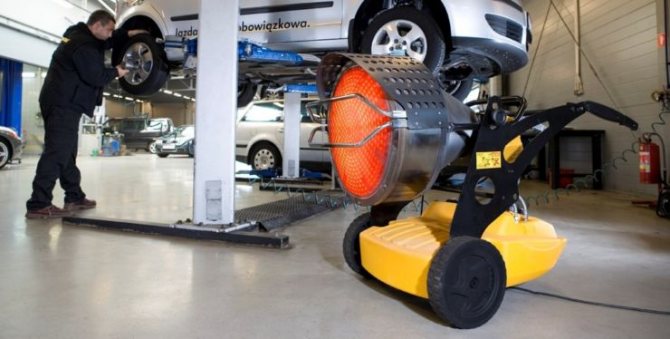

I cannot recommend such a gun for living quarters, but if you are looking for repairs, it is a great option. It dries plaster well, copes with the installation of stretch ceilings with a bang.

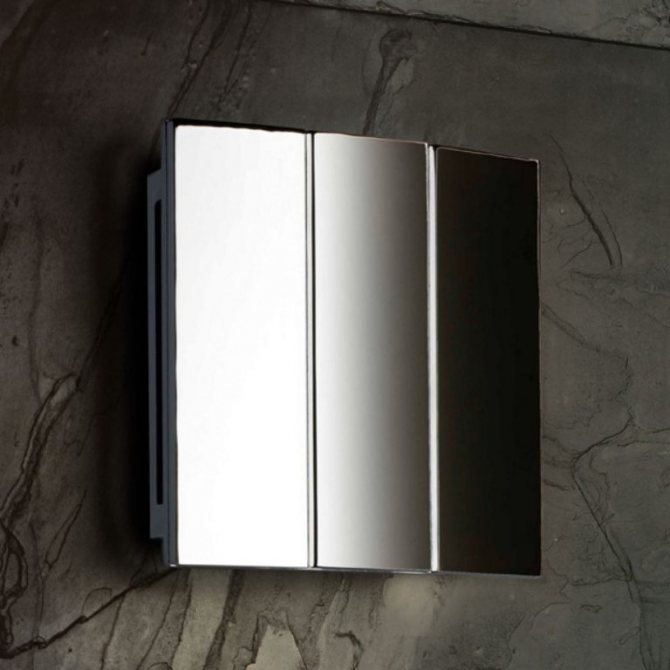
Silent fan (for exhaust) - the best ducted models of 2020. Selection features and installation instructions- Mobile air conditioner - rating of the best models for the home of 2020. Advantages and disadvantages of modern devices

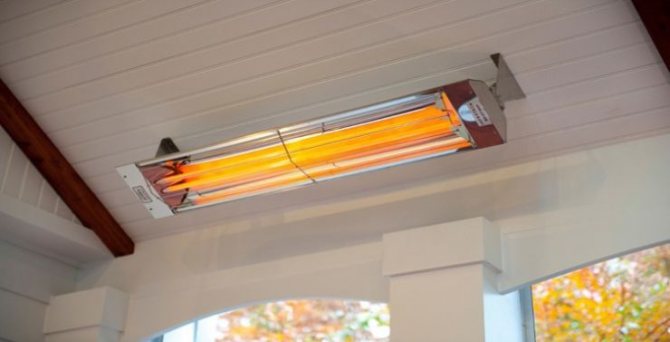
Infrared heater - how to choose the best model in 2020? Description of device operation and placement tips
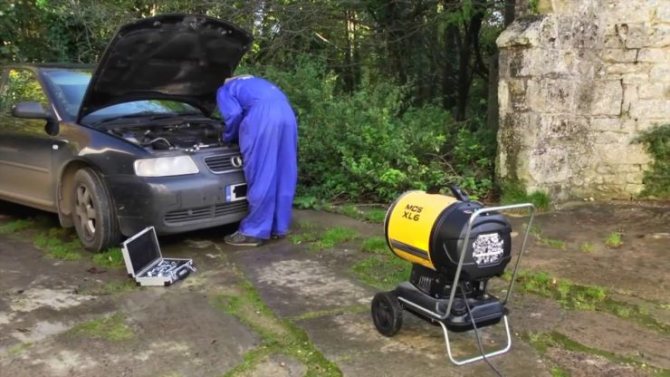

Types of heat guns and their differences
Structurally, heat guns are fairly simple devices, the main components of which are housing, heating element and fan... On the body of the gun, made of metal, which prevents both thermal and mechanical damage, there are openings for air intake. The body can be rectangular, but cylindrical heat guns are more common. It is thanks to this form, giving rise to an association with the muzzle of an artillery gun, that this type of air heater got its name. To increase mobility, rather massive and heavy devices are placed on a bed equipped with maneuverable wheels.
Inside the body there is a heating element (electric heating element / spiral or combustion chamber with a heat exchanger) and a powerful electric fan. The fan blows cold air through the holes in the housing inside the gun, drives it along the heating element and helps to distribute the already hot air throughout the room. Thus, a heat gun is inherently a powerful fan heater.
Depending on the type of energy carrier they use for heating, all heat guns are divided into:
- Electrical;
- Gas;
- Diesel;
- Multi-fuel;
- Infrared.
Below we will consider each of the types of heat guns listed above, talk about their structure, principle of operation, main areas of application, advantages and disadvantages.
Infrared heat guns
Infrared heating devices stand out in the row of heat guns, because they are fundamentally different from all the types discussed above. The heat generated by such a heater reaches the surface to which the gun is "aimed", not in the form of a stream of hot air, but in the form of radiation. The heated surfaces of walls and individual objects that fall into the radiation zone transfer their heat to the surrounding air. The air heating rate in this way is much lower than with fan heaters, and whether the heating will be general or only local depends on the size of the room. However, being in the radiation zone becomes comfortable for a person in the very first minutes of operation of the heating device.
The main structural elements of an infrared heat gun are a fuel tank, a piezo-ignited burner and a reflector that reflects and directs IR radiation in the desired direction. A fan is not needed for such a heater, because its principle of operation is not based on forced convection of warm air, as in other types of heat guns, but on the transfer of energy through electromagnetic waves.
Diesel infrared heater device:


1. Deflector. 2. Combustion chamber. 3. Burner. 4. Tilt angle adjuster.
5. Hinge block. 6. Lever for moving the heater. 7. Fuel line.
8. Fuel return line. 9. Fuel tank. 10. Wheels.
Infrared guns are used in rooms with poor thermal insulation and / or high ceilings (warehouses, workshops, garages, etc.), as well as in open areas (street outlets, summer cafes, verandas). Often they are more convenient than fan heaters when carrying out repair and finishing work (for example, for drying plaster or paint), because heating the working surface directly is more rational than heating the entire room to the desired temperature.


Diesel infrared heater.


Electric infrared heater.
Electric heat guns
These are the most versatile and easy-to-use devices... A spiral made of refractory metal or a sealed tubular heating element is responsible for heating the air. The second option is considered more preferable due to its higher durability and safety. As soon as you plugged the gun into an outlet and set the temperature for heating the air, the fan begins to pump air to the spiral or heating element. A stream of warm air comes out of the device, and the room heats up instantly. The user can use the thermostat to set the maximum permissible heating temperature. When it is reached, the heating switches off, but the fan continues to run.
Electricity in such guns is consumed both for heating the heating element and for rotating the fan blades. Heat output fluctuates from 1.5 to 50 kW... Devices with a power of up to 5 kW can be connected to a regular power grid and can even be used at home. Most products are equipped with a handle for easy transport of the device and wheels for greater mobility.
Benefits:
- environmental friendliness. Electric heat guns can be used even in unventilated residential areas, since there are no combustion products at all;
- versatility. The products are suitable for heating garages, car repair shops, warehouses, greenhouses, summer cottages, houses, shops, train stations, etc .;
- easy start-up at low temperatures, when, for example, liquid-fuel analogs require prolonged efforts;
- duration of continuous work and no need to refuel with gas or diesel;
- ease of use. It is enough to buy the device and put it in the right place, you will not have to equip the chimney and buy gas cylinders;
- security.
Minuses:
- electricity is more expensive than gas and diesel, so this type of heating will cost a pretty penny;
- if you need to use a high-power cannon, you need to have a 380 V connection and be sure that there are no power outages in the region.
An electric gun is great for quickly heating a summer cottage, warehouse, office, greenhouse and other premises. As a rule, electrical appliances are used as an additional or backup source of heat due to the high cost of operation, but there are exceptions.


Gas cannons


The power of gas cannons ranges from a few kilowatts to half a thousand. To choose the one you need for your room, you can use the previously given formula.
Although electricity is needed here, its consumption is minimal. Voltage is required to ignite and operate the fan.
The gas in such devices burns out almost completely. When connected not to cylinders, but to a gas main, such a gun becomes a stationary heat source. These models are used in industrial enterprises and in agriculture.
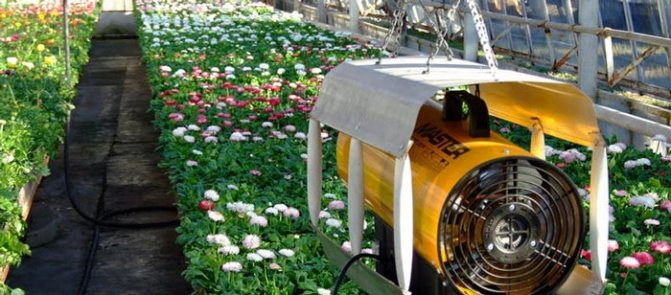

For example, they are better than others for greenhouses.
For private use (in a garage, in a building under construction), bottled gas - butane or propane - is also suitable. From stationary, the heater becomes mobile.
To reduce gas consumption and the flame itself, many change the factory frog that comes with the kit for an adjustable reducer.


The advantages of gas models:
- most even heat distribution
- the air is heated by a gas burner
- there is piezo ignition
- electricity consumption no more than 0.5 kW / h
Natural gas cannons can be used to heat buildings with large numbers of people - shops, hypermarkets, auto and railway stations, airport.
However, do not forget that when working in confined spaces (especially a small garage or house), it is imperative to provide an influx of fresh air. At least periodically open and close the doors.


The smell of gas will still be felt and you will feel it through slight dizziness.
Therefore, such models in small areas are used only for quick initial warming up, and then move on to something else.
Inhalation of vapors from this gun for several hours does not remain unnoticed. Saw yellow flames on a gas burner - beware of discharge
carbon monoxide.


The entire flame is bluish - only carbon dioxide CO2 is emitted.


When using a gas heater, do not forget about such an effect as condensation. If you entered a garage where the temperature was -10C, and after 15 minutes you brought it up to + 20C, the formation of moisture droplets is an inevitable phenomenon.


When about 2 liters of gas are burned, about 1 liter of water is released in the form of water vapor.
Moisture, of course, gradually goes away, but it is not recommended to immediately turn on the "wet" equipment after such a warm-up. Wait until it dries.
If there are any electronic devices and tools in the room, it is better to cover them in general with plastic.


When buildings and garages are heated from very low temperatures from -20C and further, you may encounter another problem. The fan in such a frost will not gain momentum well. During this period, you should not immediately apply gas. As soon as the blades spin up, then turn on the feed.
It also happens that the thermal relay freezes and the gun refuses to work. In this case, the "kulibins" first start up the 220V generator, and the relay is warmed up from its exhaust. After that, the cannon itself is launched.
Don't forget about the noise. The more powerful the unit, the more noise comes from it. If you are not working alone, then you have to literally shout over each other. Yes, and alone after an hour of such work, you will no longer want any warmth.
Diesel cannons
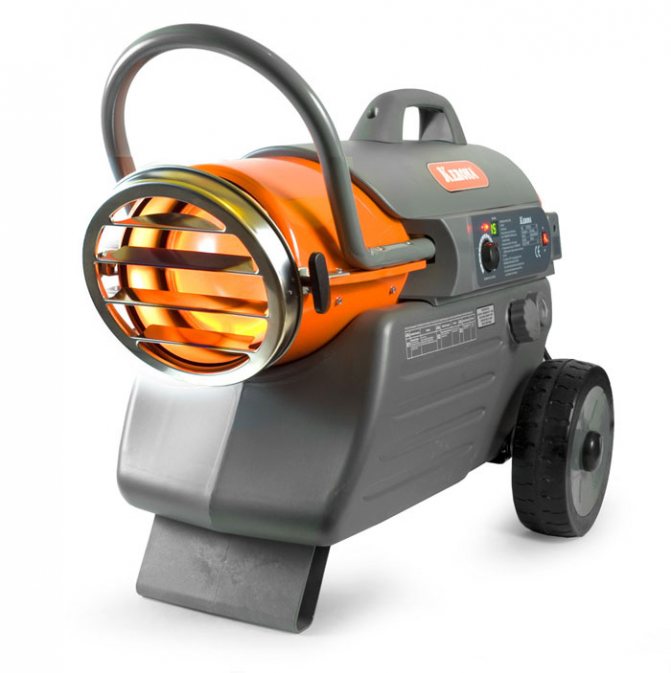

Diesel engines have a capacity of 10 to several hundred kilowatts.... They are divided into direct and indirect heating models.
The greatest power is characteristic of the former. However, both types of high power are mainly used only outdoors.


Direct heating guns cannot be used indoors. Carbon monoxide is colorless and odorless, and you won't even notice when you turn off.
Indirect heating devices usually deliver power up to 85kW.
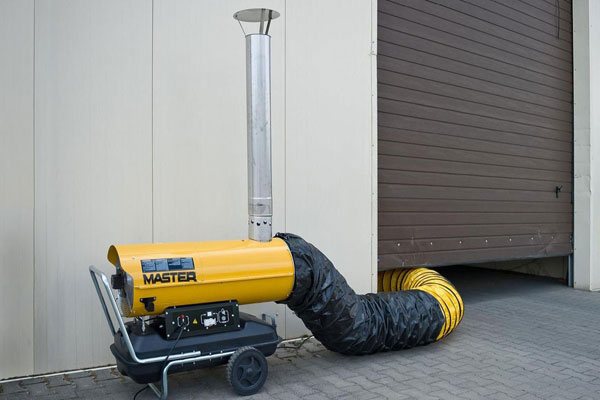

In addition to diesel, different guns can be used as fuel kerosene or waste oil... These are the so-called multi-fuel specimens.
Often they are bought by car service owners. You no longer have to throw away and dispose of waste and waste. Instead, they can be burned profitably.


Diesel cannons of direct heating have high efficiency. At the same time, pay attention, those firms that indicate specific efficiency figures, and do not write abstract values up to 100%, more than 98%, usually produce really high-quality products, which are backed by real measurements and tests.
These leading manufacturers include cannon models from Ballu Biemmedue or the American company Master.


The continuous operation period of direct combustion models reaches 10-15 hours, depending on the size of the tank. If the heater is equipped with a thermostat, then one refueling may be enough for up to a day of continuous operation.
It must be remembered that in addition to burning oxygen, these models also emit exhaust gases. Sometimes the feeling as if you are standing next to Kamaz does not leave.


So if you decide to use it not on the street, but in a building under construction, take care of supply ventilation and a constant supply of fresh air.
For the street, this is certainly a great option, especially for warming up frozen cars in winter. No gas cylinders and reducers for you.


Multi-fuel heat guns
Multi-fuel heat guns can operate on different types of fuel:
- diesel,
- kerosene,
- used engine oil.
They work on the same principle as diesel cannons, but are more versatile in terms of the choice of liquid fuel. They are also produced with direct heating and with combustion of fuel in a chamber with exhaust gases (not direct heating).
They are popular for heating car services and garages, since they can run on used engine oil, dispose of it.


Multi-fuel heat gun
Water heat guns
As the name suggests, the operation of this type of heat gun requires the presence of water, which is poured into a special heat exchanger. During the operation of the gun, the water heats up, after which the resulting heat is transferred to the environment.
The main advantage heat guns of this type in their economy and efficiency - very little electricity is spent... Basically, a water heat gun is very similar to a battery with a fan. The latter is needed to distribute heat in the room.
Water heat guns are used in greenhouses or in warehouses: heating of these structures is not fast, and a gun of this type perfectly saves energy.
How to choose an electric heater gun
Before you go to buy a fan heater, you need to clearly understand why you need a heater at all. If air heating is required occasionally and quickly, then an electric heat gun is ideal for such modes.
If the temperature needs to be maintained in the room for a long time and at a constant level, then it is better to look for another option, otherwise the electricity bills will “please” you with simply huge amounts.
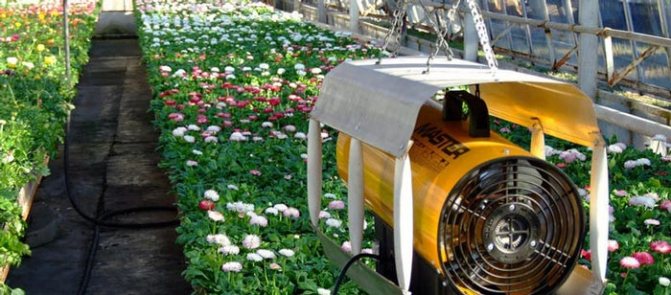

With the help of a working electric heat gun, the desired temperature regime can be maintained for a sufficiently long time, but much more often the device is used for quick and short-term heating
It is also necessary to determine in advance the required power (depending on the volume of the room) and power supply. Powerful industrial and semi-industrial models require three-phase voltage to operate.
If there is only an ordinary single-phase outlet in the room, then the electrical equipment should be selected accordingly.
For heating the foundation
Warming up the foundation is required for concrete to gain strength, and it gains it only at a temperature of +5 and above. After the installation, the foundation is covered with a film and heat guns are installed under it, creating a greenhouse or, according to the construction "greenhouse", maintaining the required temperature for some time until the foundation has gained the necessary strength.
For heating the "hothouse", depending on the availability of fuel, cannons are used:
- gas,
- electric,
- diesel,
- multi-fuel.


Teply for warming up the foundation
Warming up the foundation can be done in other ways, but this is a topic for another article.
Heating of living quarters
For heating residential buildings and apartments, a centralized heating system is mainly used, or autonomous, for private houses.
In such rooms, a gun is essentially not required and it can be used as an additional source of heat, applicable:
- electric guns,
- water.


Heating with a gun in the country in winter
Another option is to use it in the country in winter. In such conditions, if the house is not insulated, a powerful gun will be required, but it is not advisable to use it for a long time, since it will be cheaper to insulate the building than to heat a country house in winter for at least one season.
For country houses, you can use electric heat guns and any others with exhaust gases, not direct heating. Use gas cannons with caution and good ventilation.
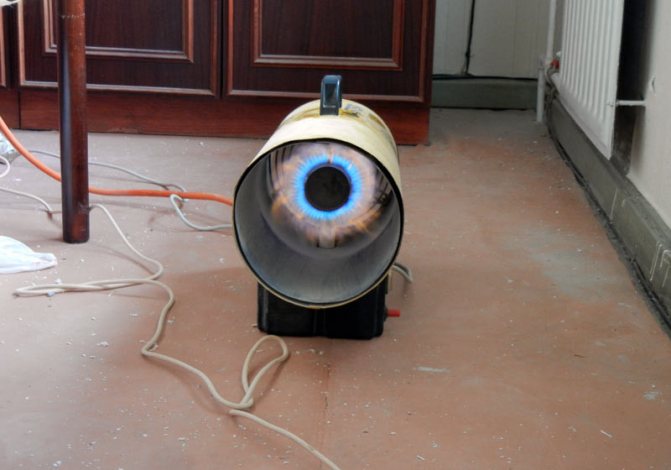

Gas heat gun
Drying walls and floors in renovation work
Often in repair and finishing work, there is a need for additional drying of the room or materials already applied to the walls, floor. For example, it happens that you need to forcibly dry the plaster or screed, self-leveling floor. With high humidity in the room, this is permissible, but with restrictions, since the solutions must dry in "natural" conditions, at temperatures from 20 degrees and not high humidity (usually all this is indicated on the packaging with the compositions).
For such work, infrared guns are used, which can be directed directly at an object (wall). Electric heat guns are also widely used, less often gas ones, which have more power, but require balloon gas.
The surfaces should be carefully dried so as not to overheat and overdry them, otherwise they may dry out, water will come out faster than necessary and chemical processes in solutions will not be completed, which will lead to cracking and a decrease in strength.
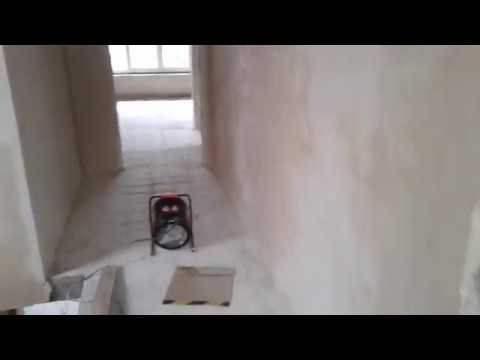

Drying plaster with a gun
Choosing a heat gun for heating a car workshop
Since the car locksmith's workshop is a closed room in which people are constantly present, direct-heated liquid fuel cannons cannot be used here. The entry of fuel combustion products into the room will inevitably cause a deterioration in the well-being of the personnel working in the auto repair shop, which means that very effective forced ventilation, open doors and windows will be required, which can negate all efforts to heat the room.
Electric heat guns, despite their ease of use, are impractical to use in such buildings, because, given the high cost of electricity, heating a room that is large in volume is equivalent to kindling a stove-stove with banknotes. For heating closed rooms with a volume of more than 300 cubic meters, the best option would be to use gas and indirectly heated diesel cannons.
Many garages prefer to install waste oil heat guns, since this type of fuel is available there in large quantities and completely free of charge. But in this case, it is necessary to remember about the need for the mandatory installation of a high-quality ventilation system to replenish the burnt oxygen.
For heating greenhouses
For heating greenhouses, liquid fuel cannons are applicable, as well as gas cannons. Thanks to indirect heating, it is fashionable to remove gases from greenhouses and ensure a good and warm microclimate in the greenhouse. Gas cannons of direct heating are also used, the use of electric cannons is expensive and not advisable.
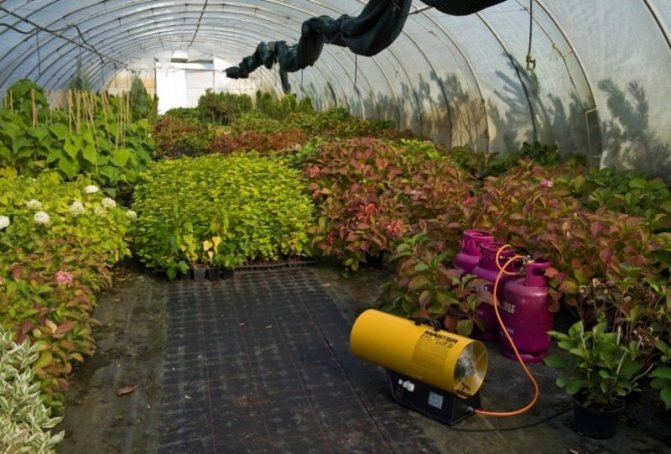

Gas cannon in the greenhouse
We examined the types of heat guns and options for their use in various rooms and places. The choice is yours! Remember to calculate the power when buying, be sure to calculate it with the seller.
To create comfortable conditions in gazebos, outdoor cafes and other outdoor recreation areas
In this case, we recommend that you use a device that heats not with an air stream, but with radiation energy. Infrared heat guns are ideal for open areas, since they do not heat the air, which is absolutely irrational outdoors, but the objects at which they are directed. Infrared guns also have one more indisputable advantage - the absence of unnecessary background noise, which will make your stay even more comfortable.
Aquatic
Heat guns are also water guns. These are connected to heating systems and help improve space heating. They work on the basis of a heating element that passes heated water through itself.
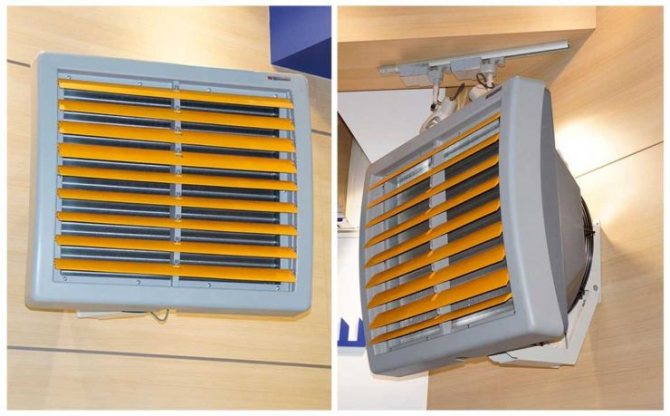

When buying such a model, you should forget about saving - only expensive and high-quality models of modern design will be able to work for a long time and reliably.
Cannon selection criteria
The gun should also be chosen based on its characteristics.
Thermal power and its calculation
How do you compare several different instruments in terms of performance? How to understand that one device is designed to heat small garages, while another can easily heat up a huge warehouse? It is necessary to look at the power indicator, and we are not talking about the consumed electrical power, or rather, not always about it. This parameter will be indicative only for electrical models. So let's start with them.
The power of electric guns ranges from 1 to 50 kW. It is difficult to name 1-3 kW models and cannons - these are rather fan heaters. We repeat, devices with a power of up to 5 kW can be connected to a 220 V network. Anything larger is equipment that requires a 380 V network. The most powerful electric guns are devices up to 100 kW.
The power of gas appliances is from 10 to 150 kW, but more powerful devices are often found. Diesel and multi-fuel direct heating devices give out all 220 kW, but their counterparts for indirect heating are less powerful - a maximum of 100 kW. Infrared guns are rarely more powerful than 50 kW.


How do you know how much power is needed? Many advise using an approximate calculation method, according to which 1-1.3 kW of power is enough for 1 m2 of room. If the room is low and well insulated, it can be multiplied by 1 kW, and if there are problems with thermal insulation, then it is better to take a factor with a margin.
If you want to get a more accurate result, then arm yourself with a calculator and the following calculation procedure:
- calculate the volume of the room, since this parameter is much more important than the area parameter. If you take a room with an area of 90 m2 and imagine that the ceiling height in it is 4 m, then the volume will turn out to be 360 m3;
- temperature difference between the desired value inside the room (for example, + 180C) and the value outside the walls. On the street in winter, the weather can be different. It is usually recommended to take into account the average winter temperature, making allowances for possible frosts. If the cannon is the main source of heat, then it is better to take into account the lowest winter temperature. If you are calculating for a residential building, then choose a comfortable internal temperature yourself. For warehouses, the accepted temperature is + 120C, for public buildings - + 180C.

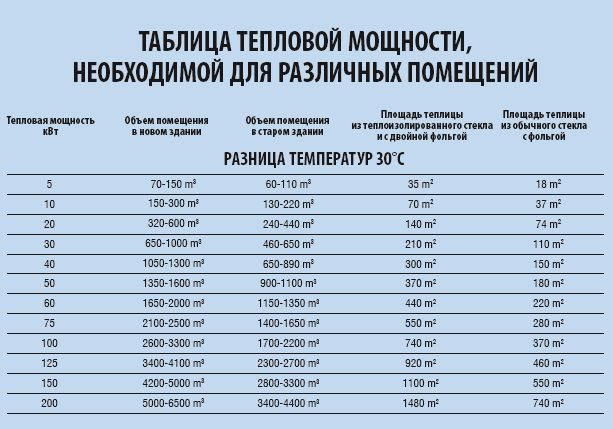
- So, let's say that in winter there are often frosts on the street down to -200C, but inside it is necessary to maintain the temperature + 180C, then the difference will be 380C;
- room thermal insulation plays an important role. A special factor is taken into account when calculating the power of the gun. If all walls, floor and roof are insulated, the number of windows is small, they have double frames, then k = 0.6-1. If the walls are brick, but without insulation, the roof is standard, and the number of windows is average, then k = 1-2. For structures with a single brick wall, single window frames (garages, for example), the coefficient k = 2-3 is used. For open and semi-open areas, simplified wooden and metal structures without thermal insulation, k = 3-4. Let's say we have a garage with double brick walls without thermal insulation, which will be more or less often visited by visitors, then we will assume that k = 1.8;

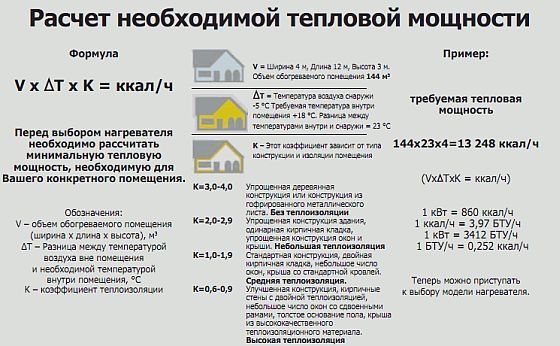
- thermal power is calculated according to the formula Q = k * V * T. Then we get Q = 1.8 * 360 * 38 = 24 624 kcal / h, and since in 1 kW there are 860 kcal / h, it turns out that Q = 24624/860 = 28.6 kW;
- if the gun is not the only source of heat in the room, then it is necessary to take this into account and subtract the power of the existing equipment from the final result;
- you can take not one high-power cannon, but a few smaller ones, in order to eventually get the required power. If the room has a complex configuration, then several less powerful guns are even better than one more powerful one.
Heat gun dimensions
The higher the power of the gun, the larger it will be, which is not surprising. The most compact and mobile are electrical appliances. Households weigh from 3 to 5-7 kg, and some industrial ones reach 30 kg. Thanks to the wheels and the handle, such devices can be easily moved, only the length of the wire will be a limitation.
Gas cannons are also relatively compact and lightweight, and if bottled gas becomes the fuel source for them, then mobility will be fine. If you use main gas, then any cannon will become stationary for some time.
Diesel and multi-fuel guns are considered to be the largest, since they also have a fuel tank. When it is completely filled with liquid fuel, the weight of the device increases. Moving a heavy liquid fuel cannon is not easy, and if a unit with indirect heating is selected, then it is not at all possible to move the device from its place, because it is connected to the chimney.
In special cases, giant heat guns are used, the weight of which is calculated in tons. Naturally, such equipment is stationary, since even for its transportation, special vehicles are required. Mainly used at production sites.
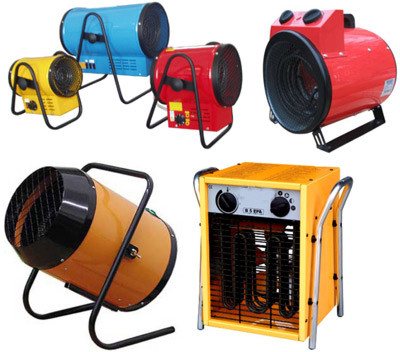

Other technical characteristics
To assess whether this or that equipment suits you, it is necessary to analyze a number of some additional parameters:
- air flow rate, m3 / hour. The indicator shows how well the fan is working. Ideally, it should be powerful enough to quickly warm up the air around it and prevent overheating of the air in the immediate vicinity of the cannon. The amount of air flow is the volume of warm air that the device can generate in 1 hour of operation. The higher the power of the cannon, the greater the air flow. The indicator ranges from 100-150 to 800 and more m3 / hour;
- air stream length, m This indicator also depends on the power of the fan and gives an idea of how far the device can send the air stream;
- fuel consumption, kg / h or l / h helps to assess the efficiency of the device. It makes sense to compare the parameter at the same power of the samples;
- noise of work, dB. All the cannons that are powered by the fan are noisy. The higher the power, the higher the noise level. If compact electric guns give out only 40-50 dB, then large gas and diesel cannons can give 80-90 dB, which will interfere in a small room. If the noise level is a critical indicator, then it is better to leave the choice on the infrared model;
- duration of work... If the cannon is the only source of heat, then it is important that it can operate practically around the clock.In the description of the model, you can see something like this 24/1 or 24/2. This means that the device can rest for 1-2 hours per day.


